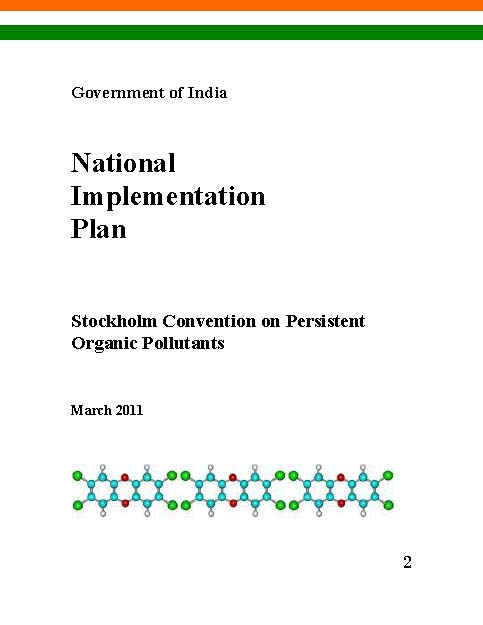 As per Article 7 of the Stockholm Convention, countries are required to develop the National Implementation Plan (NIP) of the Stockholm Convention on Persistent Organic Pollutants (POPs) to demonstrate how the obligations under the Convention would be implemented. The Convention was adopted with the objective of protecting human health and the environment from POPs and came into force from April 2006 in India.
As per Article 7 of the Stockholm Convention, countries are required to develop the National Implementation Plan (NIP) of the Stockholm Convention on Persistent Organic Pollutants (POPs) to demonstrate how the obligations under the Convention would be implemented. The Convention was adopted with the objective of protecting human health and the environment from POPs and came into force from April 2006 in India.
The Ministry of Environment and Forests, which is the nodal ministry for the Global Environmental Facility (GEF) and Stockholm Convention in India has prepared a NIP and has committed itself to its implementation subject to adequate assistance. It has had to harmonize the interests and stand points of different sectors involved and thereafter determine the position of the Indian government.
India understands that compliance with the obligations on Parties set out in the Convention will have a significant and positive influence not only on India‘s own chemicals management regime but also on the ultimate global success of the Convention. Since among the POPs only Dichloro Diphenyl Trichloroethane (DDT) and Polychlorinated Biphenyls (PCBs) are used in the country the inventory concentrated on DDT storages and facilities where PCB-containing electrical equipment was found.
Based on the consultative NIP development process, the Government of India has identified the following priorities for the implementation of the NIP -
- Development and promotion of non POP alternatives to DDT;
- Inventorization of newly listed POPs;
- Implementation of the Best Available Technologies (BAT)/Best Environmental Practices (BEP) strategies for elimination/reduction of unintentional POP emissions of the priority industry sectors identified in the NIP;
- Capacity building, demonstration of production and promotion of bio-botanical neem derived bio-pesticides as viable, eco-friendly, bio-degradable alternatives to POP pesticides;
- Identification of sites contaminated by POP chemicals and of remediation process at the potential hotspots;
- POP and pesticides management in India;
- National POP monitoring program;
- Strengthening institutions and capacity building for effective and efficient implementation of the NIP in India;
- Environmentally sound management of un-intentional release of Pesticides and Dioxin (PCDDs) and Pesticides, Dioxin and Furan (PCDFs) in the metallurgical industry.
The NIP implementation has been harmonized with the five-year planning process in India and with the five-year replenishment of the GEF. In this regard the first NIP is planned until 2022. The five-year planning seeks to provide guidance to development policies and programmes that promote sustainable management of the nation‘s resources to attain the ultimate objective of sustainable development. The NIP implementation will also be integrated within the five year plans of the Government of India.
In order to effectively implement the NIP under the Convention, India has strategically put its plan in three phases viz. Short term, Medium term and Long term. The financial requirements (both baseline and incremental cost) for the NIP for India for the priority sectors are - Baseline 354.36 USD (million), Incremental 203.51 USD (million) and Total 557.87 USD (million).
The document can be downloaded here





 National_Implementation_Plan_Stockholm_Convention_on_Persistent_Organic_Pollutants_MoEF_2011.pdf
National_Implementation_Plan_Stockholm_Convention_on_Persistent_Organic_Pollutants_MoEF_2011.pdf







